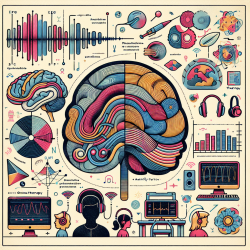Introduction
In the realm of special education, understanding how students process auditory information can significantly enhance teaching strategies and therapeutic interventions. A recent study, "Complementary fMRI and EEG evidence for more efficient neural processing of rhythmic vs. unpredictably timed sounds," provides valuable insights into how rhythmic auditory inputs can be processed more efficiently by the brain. This research has profound implications for practitioners, especially those utilizing online therapy services like TinyEYE, in designing effective auditory learning environments.
Key Findings of the Study
The study utilized both functional magnetic resonance imaging (fMRI) and electroencephalograms (EEG) to explore how the brain processes rhythmic versus random auditory inputs. Participants detected target sounds faster and more accurately when these sounds were embedded in rhythmic streams compared to random ones. This suggests that rhythmic auditory inputs are processed more efficiently, both behaviorally and neurologically.
Specifically, the study found that the fMRI response in the auditory cortex was stronger during the processing of random tone sequences, indicating higher metabolic demands. In contrast, rhythmic sequences resulted in smaller N1 peak amplitudes and shorter latencies, pointing to more efficient neural processing.
Implications for Practitioners
For practitioners in the field of special education and online therapy, these findings offer a pathway to enhance auditory processing skills in students. Here are some practical applications:
- Incorporate Rhythmic Patterns: Use rhythmic patterns in auditory exercises to improve students' attention and processing efficiency. This can be particularly beneficial for students with auditory processing disorders.
- Design Predictable Auditory Environments: Create learning environments where auditory inputs are predictable, helping students to better focus and process information.
- Utilize Technology: Online therapy platforms like TinyEYE can incorporate rhythmic auditory exercises to engage students and enhance their auditory processing capabilities.
Encouraging Further Research
While the study provides compelling evidence for the benefits of rhythmic auditory inputs, further research is encouraged to explore how these findings can be tailored to individual needs. Practitioners are urged to consider the diverse auditory processing capabilities of their students and to adapt interventions accordingly.
Moreover, exploring the integration of these findings with other sensory modalities could offer a more holistic approach to enhancing cognitive and sensory processing in students.
Conclusion
The study's insights into the neural efficiency of rhythmic auditory processing present an opportunity for practitioners to refine their therapeutic approaches. By leveraging these findings, educators and therapists can better support students in developing robust auditory processing skills, ultimately enhancing their learning experiences.
To read the original research paper, please follow this link: Complementary fMRI and EEG evidence for more efficient neural processing of rhythmic vs. unpredictably timed sounds.










